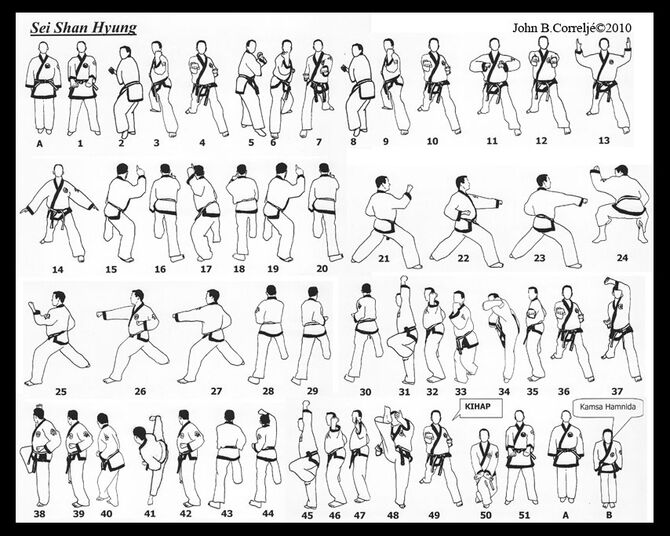This form is a traditional taekwondo form, meaning it pre-dates contemporary forms (such as those used by the ITF, ATA, and WT). In other words, this is a form used during the 1950s within the Nine Kwans that eventually came together to form taekwondo.
- Older forms such as this one were often based on forms from other martial arts.
- The details and names of these older forms tend to vary more widely from school to school as well.
The version shown here is just one version; the reader should recognize that there will be variations among schools.
The karate kata Seisan (alternate names: Sesan, Sei-Shan, Jusan, Hangetsu) literally means '13'. Some people refer to the kata as '13 Hands', '13 Fists', '13 Techniques', '13 Steps' or even '13 killing positions', however, these names have no historical basis.
Seisan is thought to be one of the oldest kata, being quite spread among other Nahate schools. Shito-ryu has its own version and different versions are now practised even in Shurite derivatives like Shotokan (called Hangetsu) and in Wado-ryu (called Seishan). Isshin-ryū also adopted this kata. This kata is also practiced in Korean styles such as Tang Soo Do and Soo Bahk Do and is called Sei-Shan or Seishan in Korean. Due to its difficulty, this kata is often reserved for advanced students.
There are numerous theories as to the naming of the kata. These include the number of steps originally in the kata, the number of different types of 'power' or 'energy' in the kata, the number of applications, or that the kata represents defence against 13 specific types of attack. The most likely explanation is the number of non-repeating techniques contained within the kata. It is believed Seisan derives from Yong Chun White Crane Boxing from Fujian Province in Southern China, where the form is known as 'Four Gate Hands'. (This is completely unproven and uncorroborated. There are some other Chinese styles having a form called 'Shisan' (13) in their curricula, but a link from a specific kung-fu form to Okinawan Seisan has never been established.)
Video
Diagram
This diagram is copyright John B. Correljé and is used with permission. Terms and conditions are available at http://sites.google.com/site/tangsoodochonkyong 
Written Instructions
See http://www.trinityshotokan.com/documents/hangetsu.html
